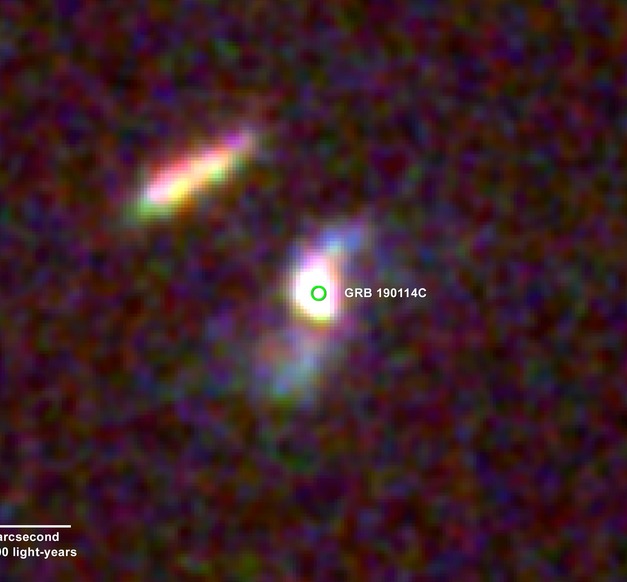
A large international team of astronomers, including scientists at the University of Iceland, have shed new light on the process behind the most powerful explosions in the universe, so-called gamma-ray bursts. The discoveries were made after space telescopes recently observed the brightest light ever recorded from two gamma-ray bursts.
Gamma-ray bursts are the brightest and most powerful explosions in the universe and were discovered almost fifty years ago. Their origins can usually be traced to the point at which a massive star, many times larger than our own sun, collapses and forms a black hole. At the same time, the star emits a powerful jet of particles travelling at light-speed out into space, which form a gamma-ray, the most energetic form of light – this process generally takes just a very short time, less than a minute.
As the aforementioned particles continue into space, they come into contact with gases and emit light across the entire spectrum, from radio waves to high-energy gamma rays. This phenomenon has been termed the 'afterglow' and can be observed many days or even months and years after the original explosion. Most discoveries concerning gamma-ray bursts in recent years have emerged from research into their afterglows.
Due to its immense brightness, the light from gamma-ray bursts in distant galaxies is easy to observe from Earth. In many cases, the light from these galaxies is so faint that it has not previously been observed, but using large space telescopes, it is sometimes possible to detect them. Such measurements would be far too expensive if it weren't for the existence of gamma-ray bursts. And since they are formed in the death of massive stars, measurements of gamma-ray bursts can provide an objective way to evaluate the history of star formation in the universe.
More information on gamma-ray bursts and their history can be found in this article on Stjörnufræðivefurinn (in Icelandic).
In February and March of 2019, the Hubble Space Telescope captured images of the afterglow of the most powerful gamma-ray burst ever observed (which was given the name GRB 190114C) and the galaxy where the burst occurred. The blue colour around the core of the burst implies the presence of hot, young stars, which in turn suggests that this is a spiral galaxy, similar to our own. The spiral galaxy is around 4.5 billion light years away, in the Fornax constellation. Image: NASA, ESA, and V. Acciari et al. 2019

Observed the most powerful gamma-rays ever recorded
A certain milestone has now been reached in gamma-ray burst research, due to the fact that scientists have recently observed very-high-energy gamma-rays from two gamma-ray bursts. These discoveries were reported in a total of four scientific articles published in respected academic journals, including the well-known Nature.
In early 2019, two NASA satellites, the Fermi Gamma-ray Space Telescope and the Neil Gehrels Swift Observatory, observed a large gamma-ray burst and immediately sent an alert. Among the telescopes used to follow-up these observations was the MAGIC telescope in the Canary Islands. Subsequent measurements and data processing showed that these were the most powerful gamma-rays from gamma-ray bursts ever detected. To give an idea of the power of these rays, consider that the power of light is generally measured in electron volts. Light visible to humans is generally between 2-3 electron volts, but these gamma-rays were measured at almost a trillion electron volts. This is ten times more energy than had previously been observed in a gamma-ray burst. Further research revealed that the gamma-ray burst had its origins in a so-called spiral galaxy, 4.5 billion light years from the Earth.
The Fermi Telescope and the Swift Observatory also observed powerful gamma-rays in mid-2018. This time, the HESS telescope in Namibia followed up the measurements. Subsequent research and calculations revealed that the gamma-rays measured at 440 giga-electron volts, making them the second most powerful gamma-rays observed from a gamma-ray burst.
A large team of scientists from both sides of the Atlantic were involved in the research, including Guðlaugur Jóhannesson, astrophysicist at the University of Iceland Science Institute and the Nordic Institute for Theoretical Physics (NORDITA) in Stockholm, and Páll Jakobsson, professor at the Faculty of Physical Sciences. Páll has spent many years researching gamma-ray bursts and Guðlaugur has been prominent for over a decade in measuring and interpreting measurements of high-energy gamma-rays and cosmic rays.
"The new measurements provide an important insight into the physical process behind the formation of gamma-ray bursts and development of the afterglow. Up to this point, it was believed that so-called synchrotron emission caused all radiation from the afterglow, but the new measurements confirm that inverse-Compton scattering also plays an important role in the formation of the light. Inverse-Compton scattering is when powerful electrons collide with photons and some of the energy in the electrons is transferred to the photons. The measurements are also important as a way to determine the amount of energy released in the explosion that causes the gamma-ray burst," says Guðlaugur of the significance of the research.
Article in Astrophysical Journal
Article related to the discovery by the HESS telescope in Nature
Article related to the discovery by the MAGIC telescope in Nature
Third article in Nature related to the discoveries



